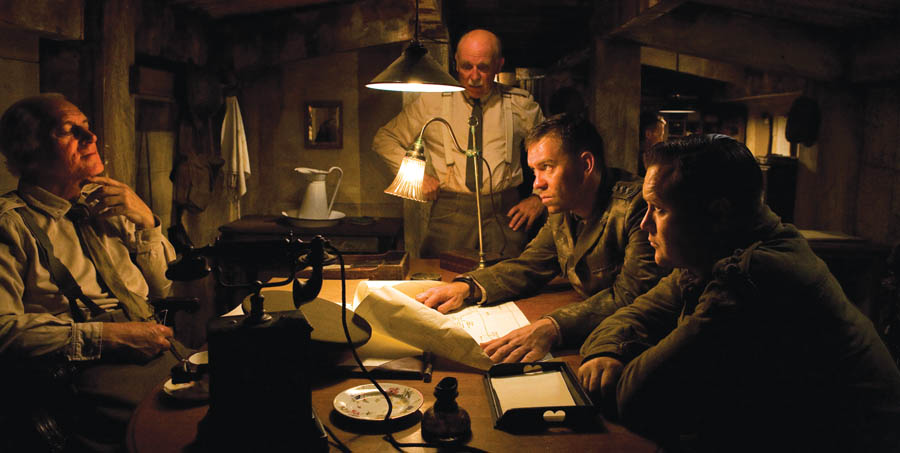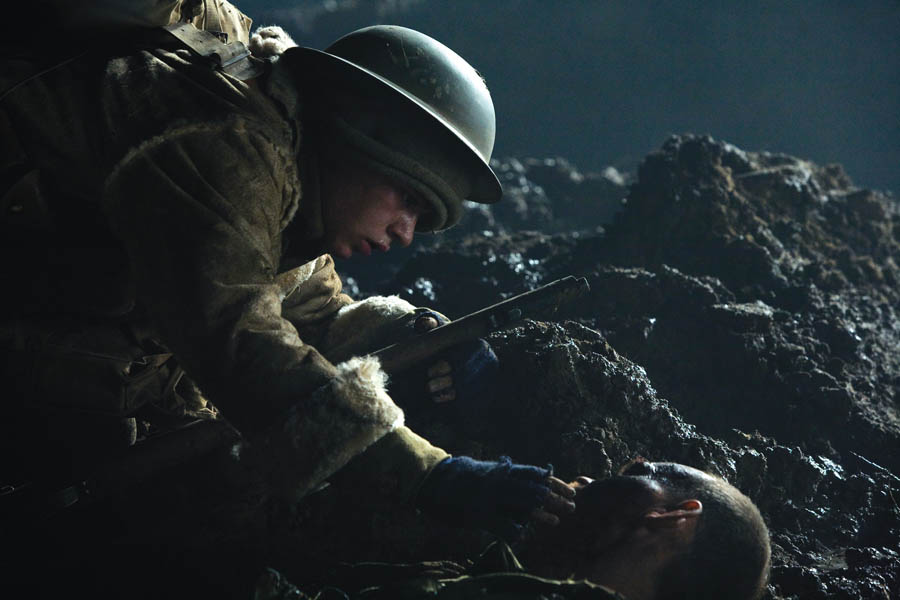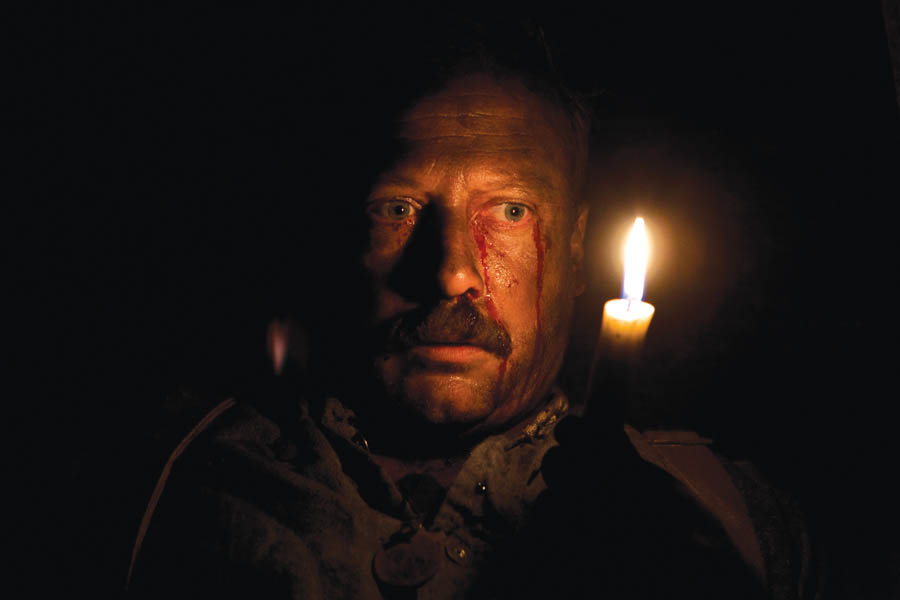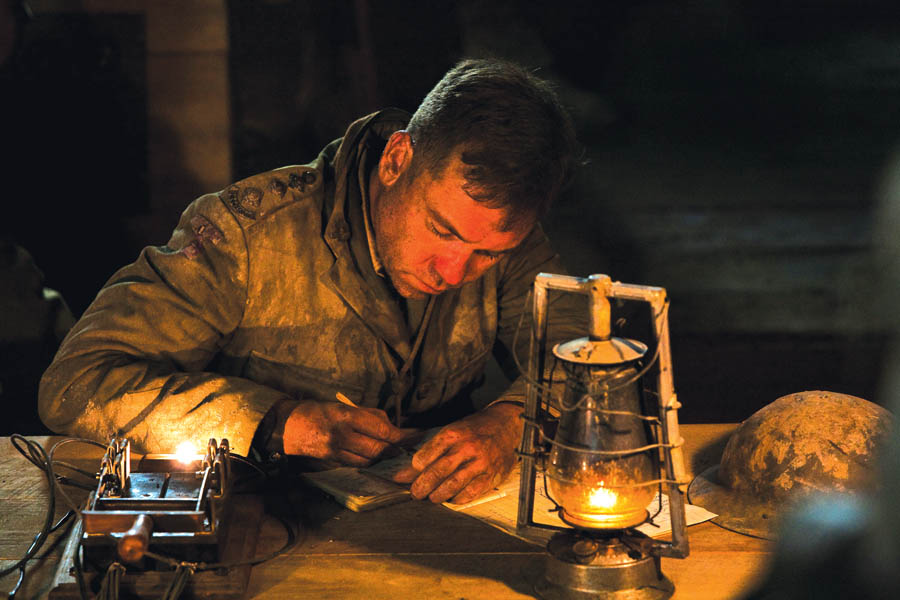|
Cutting Edge was awarded the VFX work on ‘Beneath Hill 60’ about two months before principle photography began. Two weeks before the shoot, Ron Roberts VFX Supervisor from Cutting Edge’s Sydney office, travelled up to Townsville, Queensland for on-set supervision.
Historical Research
Director Jeremy Sims and the producers were expecting to allow for about 40 to 50 major VFX shots, preparing to achieve as much as possible in camera. “Aware of their resources, many producers are simply not that familiar or comfortable with the idea of relying on effects. So a portion of my job is often education. Fortunately, this crew was more willing than some to take advice. Nevertheless, their original estimation was about half the final shot count. In the end, including more minor cleanup work, we completed about 130 shots.”
Ron explained that the film was very well researched historically, recounting as it does real events during the war and in Captain Oliver Woodward’s life. The director and producer had concerns that the look of visual effects, if not handled carefully, wouldn’t fit into the period style of the story. They were trying to prevent a stylized appearance from distracting the audience from the true story and events, and to give it a sense of authenticity.
On-set Supervision
On five trips, Ron spent ten to 12 days on set in Townsville, including the pre-shoot meetings and element shoots. “On my first visit, the local miners, who had invested in the project, advised the crew of an explosion they were planning, blowing the top off of a nearby ridge,” Ron said. “We took a small unit out to shoot this to use for elements. But it was also useful for everyone to see the actual size of mining explosions and what they looked like in terms of flying debris and clouds of dust rolling over the ground.
“The production was well prepared for practical in-camera effects. They had a significant pyrotechnic unit as part of the crew to stage practical explosions when and where necessary, plus an armory unit looking after the guns and weaponry. I was in constant communication with these teams about what could and could not be achieved practically.
Ron believes that practical effects can’t necessarily be relied on to carry a film like ‘Beneath Hill 60’, especially now when viewer expectations are so high after the last 15 to 20 years of advances in 2D and 3D FX. “That ‘big bang’ that made everyone jump on set looked rather small and ordinary when played back on film. We replaced or enhanced numerous practical explosions, and added to several of them to create a more threatening environment and give them depth.”
Football Match
The actual location for the shoot was a ploughed field in Far North Queensland surrounded by bush, while the story was to take place on a wide open, treeless landscape in Flanders. These were two quite different environments. Any scene in which the view had to extend into the distance meant work for Ron and his team. The camera crew tried hard to position the camera carefully enough to avoid the trees on the horizon, but inevitably, a certain proportion of the shots didn’t work out well this way.
“A good example of the problem was the football match the soldiers hold on the extremely muddy field. To capture the action properly, the camera needed to point wherever the actors were heading, sometimes down at ground level in the mud, other times they’d have to pan up quickly to follow the players running past with the ball – regardless of whether or not there was a bank of trees behind them.
Rotoscoping
“Throughout such sequences, we had to rotoscope a number of shots and replace the background with matte paintings because of this basic problem. In that scene alone there were 16 shots. These kinds of effects hadn’t been planned for in the original estimation. One matte painting in particular, placed behind a wide shot as soldiers pulled up and unloaded trucks, showed Ypres and the ruined Ypres cathedral on the horizon.” The skies were enhanced with smoke but not replaced mainly because they were the source of light in the shots and they needed to respect the shadows and other lighting issues.
The portrayal of extensive fields full of soldiers was another task that the production had expected to be able to deal with in camera by implication. “But, again, this wasn’t always possible. At certain points, showing the scale and magnitude of a scene graphically was important to the story.”
To help convince the production of this need, Ron worked with editor Dany Cooper, who was set up throughout the shoot at a local art college, early on when rough assembly was underway for story direction. He talked through several scenes with her particularly regarding storytelling. They started doing some rough previs for some of their ideas, and some quick matte paintings that she could put into a cut. He wanted to convince them that the story needed to feel ‘bigger’.
A Wider Scope
“Jeremy Sims has a strong theatre background,” said Ron. “His original vision for the film was more a series of intense, personal moments within confined spaces, such as the scenes underground in the mines or in the trenches.” Moving from this vision to a more filmic one that included expansive scenes of greater scale was a process that Ron feels he helped contribute to.
“It’s true that this is, primarily, a story about people – that is Jeremy’s gift. He and the acting crew were totally absorbed and very skilled in this portrayal. But eventually everyone involved was inclined to agree that a little more effort and more resources could be put into broadening the scope of the film.”
Battle Scenes
Populating battlefields with soldiers was achieved literally by cutting and pasting people from live action footage. They shot individuals two or three times in different poses, duplicated and distributed them over the shots, and edited the scenes together that way. General battle scene enhancements were another part of their work, including muzzle flashes and bullet hits. Many of the bullet hits had been achieved practically in camera by the pyrotechnic unit, and so the effects work was done to match these – spattering mud followed by smoke, usually in camera from the pyro effects.
“The final explosion was a completely CG event, bar the actors in the foreground. The views of Hill 60 itself are CG as well, mostly achieved through matte paintings and projections of matte paintings onto surfaces to give them their basic geometry – the idea of matte paintings now very often involves pushing them into 3D.”
Very little green screen work was required for the film. In fact, only in the scene in which the Red House was blown up, did they need to place some soldiers shot on green screen into the foreground. “Most every other scene was put together with laborious rotoscoping,” said Ron. “The size of our team was relatively small for a feature film, seven or eight compositors and four 3D artists. The compositing was done in Shake, and matte paintings were done traditionally in Photoshop. Modelling and projections were done in Maya but most effects and all of the explosions were handled in Houdini.”
Sunshine and Rain
When the camera moved into the trenches, other issues arose. There, the bright Queensland sun interfered with the impression of rainy, stormy, freezing cold misery. “The unit had up to five cranes with big scrims to create shade over the action,” Ron said. “In post, we had to match the exposed areas beyond that, usually by rotoscoping the foreground, pulling down the background, adding smoke to the sky, to make all the trench shots consistent. We added lots of rain to the trenches.
The practical team added lots of rain to get everything wet and rain-spattered but we needed to add rain to the air. We shot some rain plates, and had some in our library shot on black, always mindful of the scale of the wider rain shots for the backgrounds. The biggest problem was really the bright light. Grading the scenes down meant the rain often had to be replaced.”
The night scenes were captured in camera on an extensive night shoot. In many of these, the effects team added flashes and distant explosions to indicate battle activity going on around them. Some shots had to be shot over several nights due to the wind that stirred up over the set, blowing away a lot of the practical smoke. The team had to do still more rotoscoping and add background smoke to improve consistency.
When Down is Up
The scenes of Captain Woodward’s life in Queensland before the war contrasted sharply in lighting, mood – and in the need for visual effects. Cutting Edge’s work involved removing modern elements such as power lines from the open countryside. The view with the river and town in the distance was a matte painting using reference from the research team who could supply details of the looks of a number of typical mining towns in the Queensland area.
Ron was impressed that all underground lighting could be achieved in camera. His team dealt mostly with cleaning up lens elements and phantom flares – because it was so dark, these were more obvious than was usual. But he accords the tension and drama of these scenes entirely to Jeremy, the actors and the DP.
“The underground scenes were, in fact, filmed on a set in a warehouse, placed up on scaffolding so that the camera could approach from all angles. Even a scene in which water is being pumped out and camera follows pipes running into the ground, is shot on a set that climbs up into the air,” said Ron.
Final Explosion
Very few revisions were needed on the project overall. Even the final explosion had been very well prevised early in the cut, and they knew exactly what they needed to do. They had prevised several alternatives for the production to see what was achievable and figure out what they wanted. “They were really only convinced about midway through production that they would have to rely on the VFX for this explosion. That mining explosion on the ridge before the main shoot had helped them understand that practical effects weren’t going to give the scene enough impact, not even with compositing as they had first envisioned.
“One other solution they had considered was a miniature, but they left the decision a bit too late. Such a miniature would have needed to be about 30 feet long, and would have been expensive and required high speed cameras for the shoot. Once the CG decision was taken, the first step was getting simple previs into the cut, from multiple camera angles to provide options, for which we needed a locked cut.
They decided to only cut to the explosion itself after showing the light from it shining on the actors’ faces – not the ground lifting and cracking beforehand – and start showing the explosion when the fireball was already in the air. The explosion part of the shot was created in Houdini. The world they were blowing up, starting from about 50m behind the foreground plates showing the command post where the men were detonating the explosion, a trench, and some actors standing around, was made up of more projected matte paintings.
Director of Photography Toby Oliver, ACS
“The tunnel scenes, critical to this story were captured entirely in camera, lighting included, except for some enhancements given to an underground explosion,” said Toby. “Historically, the only lighting the miners had was a single candle, hand held or stuck on a wall, so our main problem was getting enough exposure on film without departing too far from reality.”
“Beneath Hill 60 was shot on Super35mm film, with ARRICAM LT cameras in 3-perf mode. I used two Kodak film stocks, Vision3 5219 500T for the bulk of the shoot and Vision2 5217 200T for some day scenes.
By Candlelight
The Art Department had managed to find Hollywood style double wick candles, which on screen have the look of normal candles but put out about half a stop more light. This makes quite a difference at such low light levels. “Some scenes, especially as the film progresses, did get a bit of extra lighting but the early scenes were lit virtually purely by candle light. Later I used some 100 watt household bulbs recessed into corners and holes in the set. About 40 per cent of the film takes place under these conditions, which is the most I’ve had to deal with.
Candles played their role but Toby also found a way of force processing the film to get double the exposure rating. “The 500T was force processed 1 stop for all the dark underground tunnel and candlight scenes, giving me 1000 ISO to work with. Also, all the underground scenes were shot wide open at an aperture of T2.0 to get enough exposure from the candles, using Cooke S4i lenses.”
Forced Processing
During forced processing, Toby explained, the lab can give the film extra processing time, which to all appearances can give it the look of a higher sensitivity. “The darker areas of the image look a bit lighter. In effect, you get more speed or sensitivity from the film. This is usually at the cost of extra grain, or it becomes more ‘contrasty’ or you get other undesirable results from pushing the film too much but the Kodak film I used, the Vision3 5219 500T, holds up very well to the forced processing procedure – I had no problems with this method and with drawing more sensitivity out of the film. That’s what I did to make it work for the candlelight and after showing the producers the test results, that’s what they decided to go with.”
“Certainly, we could have introduced brighter lights but that would have interfered with the look of the candles,” he said, “and the appearance that they were, in fact, lighting the scene. So it was a deliberate choice.” Just outside the shell of this carefully lit set, of course, was a crowd of people looking at monitors. There had been discussions in early preproduction of trying to stage the scenes in a real underground setting but the logistics of an underground crew would have been too demanding.
Mood Changes
Another deliberate decision on lighting was the sharp contrast between the wartime scenes and those of Oliver Woodward’s home in Queensland. Early in pre-production, Toby made up some mood boards composed of samples of artworks from various contemporary artists of that time such as Otto Dix and Vincent Van Gogh, collecting works of a particular mood together onto a board to illustrate how various parts of the movie should look - a board for daytime scenes of the war and a board for scenes in Queensland ‘back home’.
“They were similar in tone but quite different in light levels and colour, and we used these as a reference to decide how to light and create the two environments. Queensland was to be brighter, lighter, airy with a sunny sense of summer, so we chose different film stock and lighting and applied a different grade to finesse the look established on set. The two looks were very deliberate to express the stark difference in his life on the front.”
Digging Trenches
“Up in Queensland we were working in a paddock that belonged to one of the film’s investors. Earth moving machinery was digging up trenches, and the Art Department did an amazing job creating the Western Front. The main challenge was the huge stand of gum trees, perhaps 200m from the set, surrounding the area – nothing like Belgium! Night scenes weren’t a problem, obviously, but during the day, the trees a major issue. Even in trenches we put a lot of effort into framing out the tree tops, trying to introduce props into the frame to block them our, or using lots of smoke to diffuse the background. It was pretty hard to work with. Mostly, our strategies worked pretty well and when they couldn’t, the VFX team helped in post production.
The explosion of the Red House at night was the main ‘hero shot’ explosion that Toby had to film. “We had three cameras on this explosion, one of them high speed camera at 120fps for slow motion. But the other explosions were going on while the main action was being shot in the foreground and weren’t the main focus. For the final, CGI explosion, of course, I only needed to shoot the foreground plates, and there was another CGI shot of distant explosions where I also shot the foreground plate.
Shooting Plates
“VFX Supervisor Ron Roberts attended on these plate shooting days. His presence was invaluable to advise on what should be included and the level of interactivity required. We would have liked a bit more interactive lighting between live action and CG, but there wasn’t quite the resources and time to organise this.”
Toby really appreciated having Ron on site. It was very useful for setting up plates, and doesn’t always happen for every production. “During the shoot and much of the edit, just how the effects were going to look was something of an unknown quantity. When I finally saw them in place at the grading session, I was impressed and feel that everything Cutting Edge did fit very well with the footage.”
The rushes were then scanned at Cutting Edge on their Spirit 4K at 2K resolution and the rest of the process was digital through to the DI at the end. Toby was also pleased that he was contracted to return for the grade, another advantage that doesn’t often happen. On this film, though, he felt it was critical and really hadn’t wanted to miss it. “Adrian Hauser, the colourist at Cutting Edge, did a great job and was good to work with. It was somewhat more expensive to shoot on film but after going through the grade and seeing the results, I think it was well worth it.”
Digital Decision
“Initially in pre-production the producers, especially Bill Leimbach, were quite keen to use a digital camera system such as the RED camera, because it can give excellent results and be quite cost effective. For some time before preproduction, the RED was their preferred option. But initial tests with the candle light were not successful.
“That left us with 35mm film, the traditional option, or with the Sony F35 or the Genesis, which I knew could also work well under low light, to consider. Dean Semler ACS had used one in such conditions on ‘Apocalypto’, for example. But the problem with both the F35 and the Genesis were not their performance but their bulk and weight. The tunnel sets were small and cramped, likewise the trenches which were also full of mud. All of these scenes were shot hand held on the shoulder, so weight and size were important issues.
“The organic nature of the film image also seemed the suit the story of the men going off to war, instead of a clean, crisp digital format,” Toby said. “We ran a number of tests on the looks under candlelight, tested the forced processing, and checked these on night scenes and mocked up a small tunnel set – after comparing the results we decided to shoot on film. I used my own set of Cooke S4i lenses, which I chose knowing I’d have to keep them open for all the underground scenes. I knew they would perform well wide open under these conditions. It wasn’t like a conventional shoot where you can stop down a bit on the lens and control the situation more.”
Words: Adriene Hurst
Images: Cutting Edge and Toby Oliver ACS
|























